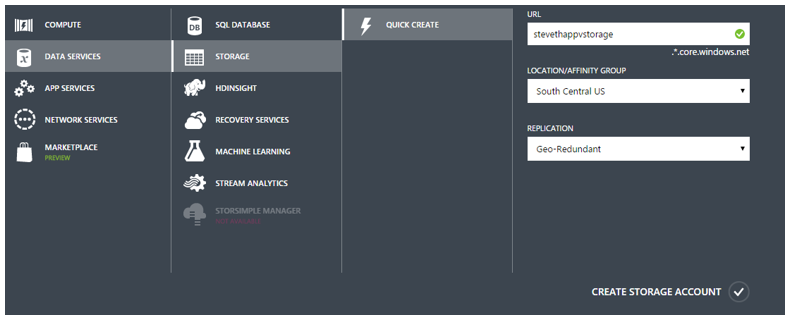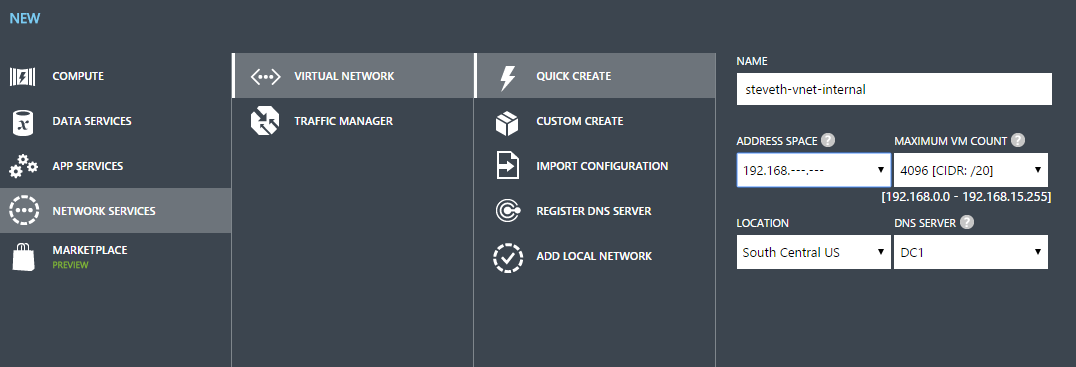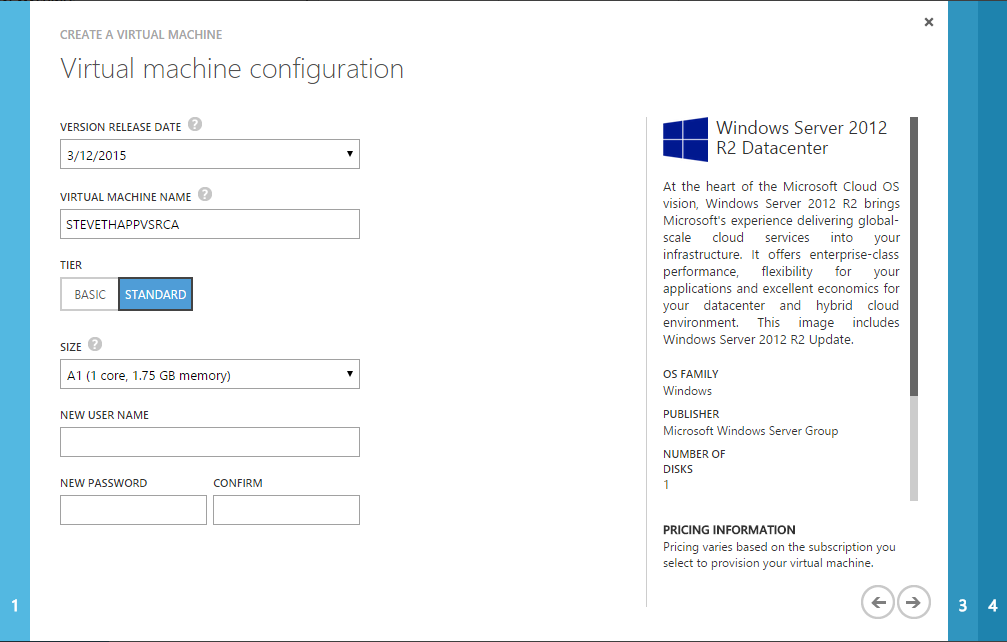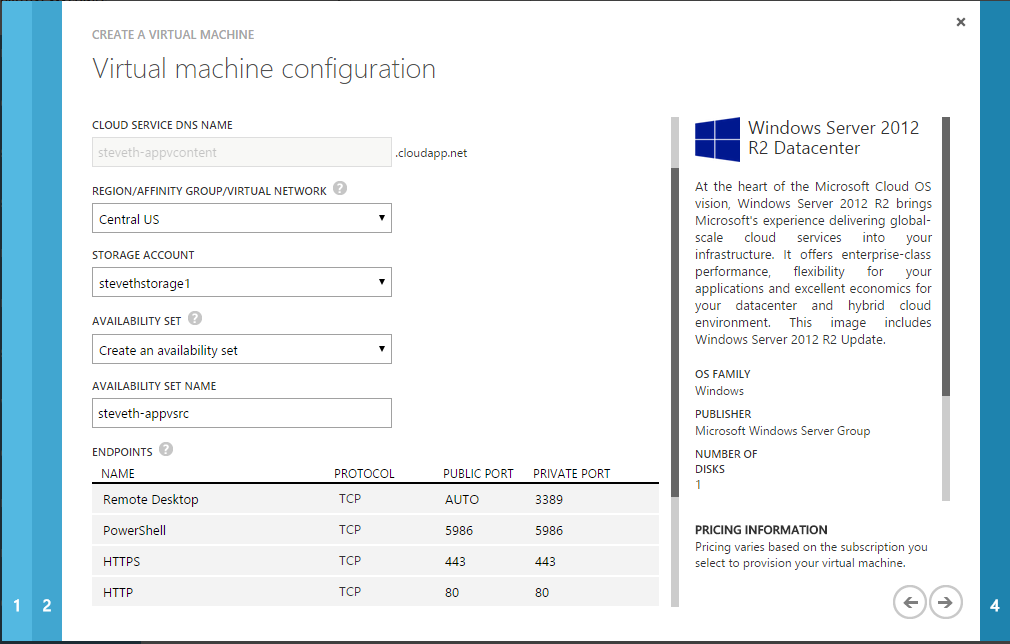On App-V with Azure: Streaming Applications from the Cloud
In App-V in general, the Content Store (also referred to as the package source or streaming source) is the most critical in both traditional streaming (stream-to-disk) scenarios and Shared Content Store mode clients (stream-to-memory.) Traditionally, Microsoft recommends placing Content Stores as close as possible to end user devices when possible leveraging on-premise technologies such as DFS-R to for replication and location. But what about those customers who are looking to leverage cloud services for App-V content for either:
- Disaster Recovery/Business Continuity solutions
- Internet-Facing Scenarios
- Part of an overall strategy to migrate from on-premises resources to hosted cloud services.
When looking to deploy Content Servers in Azure for application streaming, it is important to plan for regional proximity with a mechanism for replicating uniform copies of the App-V content just as you would have done in an on-premises environment.
Why Azure Web Roles can work for App-V Streaming
The App-V Content Server in the cloud is simply a hosted web server virtual machine with attached storage configuration and a corresponding set of cloud services configured to allow downloading of APPV package content via HTTP or HTTPs. This package source requires no additional management (other than security and MIME configuration for .APPV files) of the static package content and is simple to deploy and scale out as needed.
Cloud Services and Endpoints
Assuming you have established an Azure subscription, setting up the necessary services is essential however, a lot of the minor configuration will vary depending on how these cloud resources are integrated within your existing App-V infrastructure. For the sake of example, I will use the scenario of deploying a Content Server to the cloud for the purposes of providing cloud-based content.
In most cases, the order will be to:
- Create the Cloud Service - to allow access to hosted Content VM's over the Internet
- Create the Storage Account to store the VHDs.
If you want to learn more about Storage Accounts, the reference “What is a Storage Account?” https://azure.microsoft.com/en-us/documentation/articles/storage-whatis-account/ is a good start especially when understanding storage redundancy options.
- Create the Virtual Networks
In addition, you will be leveraging external-facing Virtual IP’s (Public IP) an internal DIP, and an Azure Traffic Manager resource
Why do I need a Cloud Service, Virtual Network, VIP and DIP?
If you want to learn more about Cloud Service, Virtual Network, VIPs and DIPs, I highly recommend Young Chou’s (My buddy in DPE from Charlotte, NC) article on Windows Azure Infrastructure Services IP Address Management - at: https://blogs.technet.com/b/yungchou/archive/2014/03/17/windows_2d00_azure_2d00_infrastructure_2d00_services_2d00_ip_2d00_address_2d00_management_2d00_part_2d00_1_2d00_of_2d00_2.aspx
In addition, the following tutorials can walk you through the process:
- How to Deploy a Cloud Service: https://azure.microsoft.com/en-us/documentation/articles/cloud-services-how-to-create-deploy/
- Setting up Endpoints: https://azure.microsoft.com/en-us/documentation/articles/virtual-machines-set-up-endpoints/
- Content Management and Upload: https://azure.microsoft.com/en-us/documentation/articles/web-sites-deploy/
VM Creation and Sizing
Content Servers in Azure can be any operating system supported for web services. In the case of Azure, it will be Windows Server 2008 R2, 2012, and 2012 R2 SKUs.
For Virtual Machine sizing purposes, it is recommended to align and plan capacity for Azure VM’s using the same guidelines for on-premises using the official App-V Sizing document: https://technet.microsoft.com/en-us/library/dn595131.aspx
I have found in my early testing with customers and myself, it is economical to scale out Standard Tiers using A1 or A2 series VM’s and load-balance as needed since we are only serving up web content essentially. I’ll also explain another reason when diving into the streaming protocol selection.
Internet Facing Scenarios
For App-V client retrieving content from cloud-based servers, there are three important factors to consider:
- Streaming/Performance
- Streaming/Bandwidth Costs
- Security
Streaming
For Azure Web Services, streaming APPV package content from the cloud is quicker using HTTP although the tradeoff of non-secure transmission may not meet all security requirements of some organizations. For those organizations, additional security of the cloud services for HTTPS communications will be required. Also you will need to flip the App-V clients to use single-range HTTP communication as opposed to multi-range.
BranchCache is Your Friend
To ensure fast, optimal delivery for on-premises App-V clients, and to provide the best experience possible for devices that may use the stream-to-disk scenario with clients – it is recommended to have the clients configured for BranchCache in either hosted mode or distributed mode. In addition, it is NOT recommend the use of Shared Content Store mode for on-premise clients due to limitations of offline access and heavy latency with the single-range HTTP protocol. Potential latency that may come with Single-range protocols would be offset and optimized by use of the BranchCache protocol. In addition, BrancheCache can reduce traffic overall to the cloud.
Security
In addition to security content transmission, you will want to secure access between your on-premises clients and the Azure-hosted cloud services. If the on-premises domain for which the App-V Client’s belong is federated with an Azure AD domain, you can secure access through individual users. Otherwise, you will need to leverage an alternative solution for restricting access.
Whitelisting IP Address Access
You can restrict access by IP address range in at least two ways. You can leverage the existing IP and Domain Restrictions feature in IIS. This will also work to secure Azure App-V Content servers to only allow access to IP addresses and domains that you have specified in a whitelist. https://technet.microsoft.com/en-us/library/cc731598%28v=ws.10%29.aspx?f=255&MSPPError=-2147217396
You can also secure access to the cloud endpoints using ACLS. https://azure.microsoft.com/en-us/documentation/articles/virtual-machines-set-up-endpoints/
Regardless of how the web service is secured on the back end. For streaming seamlessly, it is also recommended to add the URLs of the resources to the App-V Client’s Intranet Zone policy.




